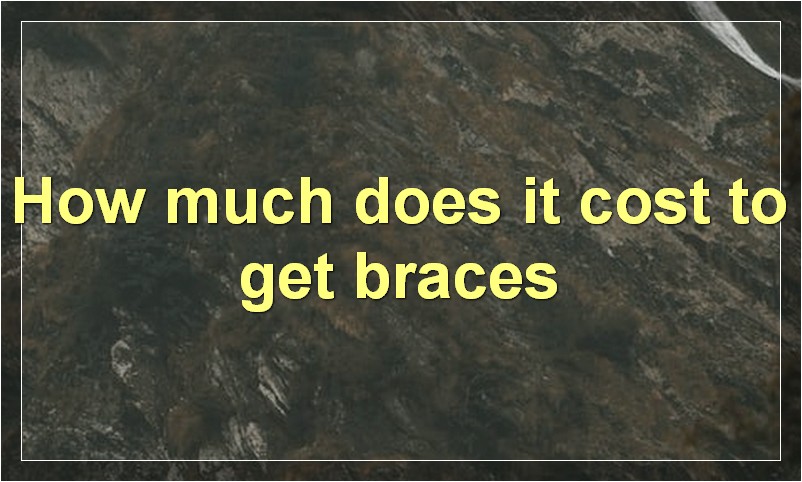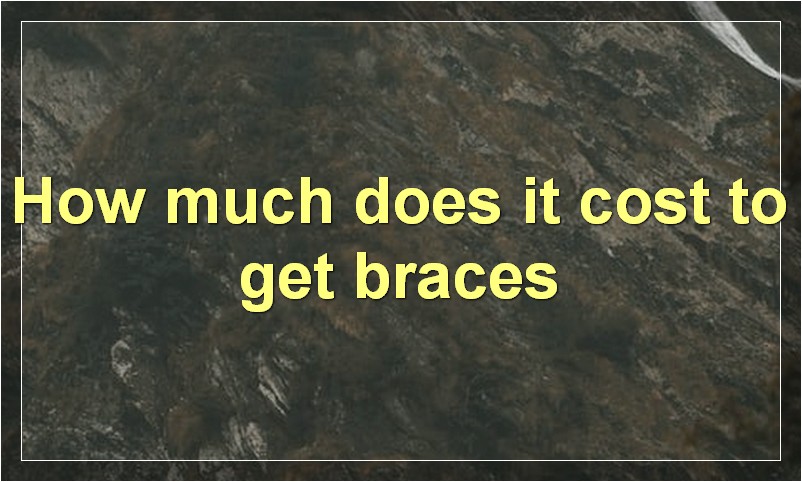If you are considering getting braces to straighten your teeth, you may be wondering how long the process will take. While the answer may vary depending on the individual, there are some general guidelines that can give you an idea of what to expect.
How long does the average person wear braces?
A recent study conducted by the American Association of Orthodontists (AAO) found that the average person wears braces for about two years. However, the amount of time that someone will wear braces depends on several factors, including the severity of the misalignment, the age of the patient, and whether or not they are compliant with their treatment plan. For example, patients who have milder cases of malocclusion may only need to wear braces for 18 months, while those with more severe misalignments may need to wear them for three years or longer. Additionally, younger patients tend to require less treatment time than older patients because their bones are still growing and thus easier to manipulate. Finally, patients who follow their orthodontist’s recommendations and come in for regular adjustments will usually finish their treatment sooner than those who do not.
How much does it cost to get braces?

The cost of braces varies depending on the type of braces and the severity of the misalignment. The average cost for metal braces is $3,000 to $6,000. The average cost for clear ceramic braces is $4,000 to $8,000. The average cost for invisible braces (Invisalign) is $5,000 to $7,000.
Are braces painful?
No one likes the idea of getting braces. The thought of metal wires and brackets attached to your teeth is enough to make anyone cringe. But are braces actually painful? The short answer is: no. In fact, most people report very little pain or discomfort after getting braces.
Of course, that doesn’t mean that there won’t be any discomfort at all. When your braces are first put on, you may feel a little pressure and soreness in your mouth. This is normal and should go away after a day or two. If the pain is severe or lasts longer than a few days, be sure to contact your orthodontist.
The other time you may feel discomfort is when your braces are adjusted. This usually happens every 4-6 weeks during your treatment. Again, you may feel a little pressure and soreness, but it should go away within a day or two.
So if you’re considering braces but are worried about the pain, don’t be! With modern technology and techniques, getting braces is easier and more comfortable than ever before.
Do braces work on everyone?
The simple answer to this question is that braces can work for just about anyone. There are, of course, a few exceptions, but in general, if you want to straighten your teeth, braces will do the job.
That said, there are a few things to keep in mind when considering braces. First, while braces can work for just about anyone, they may not be the best option for everyone. If you have very mild crowding or spacing issues, you may be able to get by with clear aligners instead of braces. Clear aligners are less visible than braces and can be removed for eating and cleaning, so some people prefer them for cosmetic reasons.
Second, even if braces are the right choice for you, they may not be the most affordable option. Braces can cost several thousand dollars, so be sure to factor that into your decision.
Third, keep in mind that braces take time – usually at least a year – to work. So if you’re looking for a quick fix, braces aren’t likely to be the best option.
fourth , it is important to realize that results vary from person to person . Some people achieve perfect results while other ‘s teeth only improve slightly
Now that we’ve answered the question, “Do braces work on everyone?” let’s take a closer look at how they work and who they’re best suited for.
How often do you have to adjust braces?
If you have ever had braces, then you know that they require a lot of upkeep. You have to be careful about what you eat and how you brush your teeth. You also have to visit the orthodontist regularly to get them adjusted. But how often do you really need to go in for a adjustment?
The answer may surprise you. According to the American Association of Orthodontists, you should be getting your braces adjusted every four to six weeks. That may seem like a lot, but it’s necessary in order to ensure that your teeth are moving in the right direction.
During an adjustment, the orthodontist will tighten the wires on your braces. This puts more pressure on your teeth and causes them to move into the correct position. The amount of pressure will vary depending on how much correction is needed.
If you don’t get your braces adjusted, your teeth may not move properly. This can lead to a longer treatment time and more discomfort. In some cases, it can even damage your teeth or gums.
So if you’re wondering how often you need to adjust braces, the answer is every four to six weeks. Be sure to keep up with your appointments and follow your orthodontist’s instructions.
What are the different types of braces?

There are many different types of braces that can be used to straighten teeth, and the type that is right for you will depend on your individual needs and preferences. Some of the most common types of braces include:
Metal braces: Metal braces are the most traditional type of braces, and they are also the most visible. They are made of high-grade stainless steel or titanium, and they are bonded to your teeth with a special dental adhesive.
Ceramic braces: Ceramic braces are made of a clear or tooth-colored material, so they are less visible than metal braces. They are bonded to your teeth in the same way as metal braces, but because they are less visible, they may be a good option for people who are concerned about the appearance of their braces.
Lingual braces: Lingual braces are similar to metal braces, but they are bonded to the back of your teeth instead of the front. This makes them virtually invisible, but it also makes them more difficult to clean.
Invisalign: Invisalign is a clear, removable aligner that is virtually invisible. It is custom-made to fit your teeth, and you can remove it for eating, brushing, and flossing.
Each type of brace has its own benefits and drawbacks, so it is important to talk to your orthodontist about which type of brace is right for you.
Will my insurance cover braces?
If you’re considering braces, one of the first questions you may have is whether your insurance will cover the cost. The answer depends on several factors, including your insurance plan, your age and the type of braces you need.
Most insurance plans cover orthodontic treatment for people under 18. If you’re over 18, you may still be covered, but it depends on your insurance plan. Some plans cover a portion of the cost of braces for adults, while others don’t cover them at all.
The type of braces also affects whether or not your insurance will pay for them. Traditional metal braces are usually covered by insurance, but other types of braces, like clear braces or lingual braces, may not be covered.
If you’re not sure whether your insurance plan covers braces, the best way to find out is to call your insurance company and ask. They should be able to tell you what’s covered and what isn’t.
Once you know what your insurance will and won’t cover, you can start looking into your options for paying for braces. If your insurance doesn’t cover the full cost, there are still plenty of ways to get the financial assistance you need to get the perfect smile you’ve always wanted.
How do I know if I need braces?
While some people may need braces due to visible dental concerns, others may not realize that their smile could be improved. Here are a few ways to tell if you or your child may need braces:
Your teeth are crowded or too close together
This can cause difficulty cleaning your teeth properly, which can lead to tooth decay and gum disease.
Your teeth are rotated or out of position
If your teeth are not aligned properly, it can affect the way they function. This can also lead to uneven wear on your teeth.
You have gaps between your teeth
Gaps between your teeth can cause food to become trapped, which can lead to tooth decay and gum disease. They can also affect the way your teeth function.
Your bite is incorrect
An incorrect bite can cause pain in your jaw and head. It can also lead to uneven wear on your teeth.
Your teeth are cracked or chipped
Cracked or chipped teeth can be painful and difficult to clean properly. They can also lead to tooth decay.
When is the best time to get braces?
There is no definitive answer to this question as each person’s individual needs vary. However, there are a few general guidelines that can be followed in order to ensure that you or your child gets the most out of the orthodontic treatment process.
The American Association of Orthodontists recommends that children have an orthodontic evaluation by the age of seven. This is because some problems with the teeth and jaws can be easier to correct if they are caught early. For instance, early treatment can prevent the need for more invasive procedures later on down the road.
That being said, there is no “right” age to get braces. Some adults opt for treatment in order to correct problems that they have had since childhood, while others make the decision to finally straighten their teeth after years of considering it. Ultimately, the best time to get braces is when it is right for you or your child.
If you think that you or your child may benefit from orthodontic treatment, the first step is to schedule a consultation with an orthodontist. During this appointment, the orthodontist will assess your individual needs and develop a personalized treatment plan. Once you have all of the information that you need, you can then make an informed decision about whether or not now is the right time to get braces.
Can I remove my own braces?
The short answer is no. You should always consult with an orthodontist to discuss the best treatment for your smile. However, there are some people who attempt to remove their own braces at home. This can be extremely dangerous and we do not recommend it.
Removing your own braces is not recommended for a number of reasons. First, it can be very painful. Second, you could damage your teeth or gums in the process. Third, you could end up with crooked teeth if you do not remove the braces correctly. Finally, removing your own braces is simply not necessary – an orthodontist can remove them for you painlessly and without any risk to your smile.
If you are considering removing your own braces, we urge you to reconsider. Schedule an appointment with an orthodontist instead so that you can get the professional care that you need.




